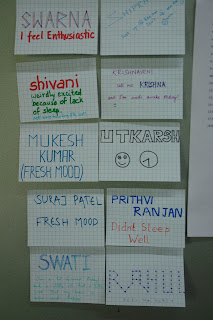This Thursday morning until Friday afternoon, we had a peer to peer feedback session on our progress so far. In a three member panel, we each became a jury member equal to another group!
Though we smiled about it at first, it worked out pretty well by the end. The feedback was detailed, critical and helpful.
First of all, it was not just our own group feedback that rung the bell in our heads. Even while we sat for others, we realized very important things. For instance, we hadn't, so far, penned down our Vision Statement. What is it that we are trying to do ultimately? Of course, we had thought about it now and then, but never so seriously to define it.
So once we got down to it, we figured that in the whole Judicial System, the most important person is the Litigant. It's his problem and his right to get justice. All the others in the way; the lawyers, the judges, the staff; they're all simply facilitators. So we defined our Vision Statement to making it easier and quicker for the litigant to get justice; to reduce his unnecessary anxiety and make his entire experience less taxing. Why should he have to go through so much trouble just to get what he must rightfully have?
On the same lines, there were other points that came up in the discussion. There is always fear of something that we do not know about. So since people don't know about the working of the Judiciary, they're afraid of getting stuck in it. And clearly, we don't remember any of our civics lessons well enough that they be of any assistance. And one fine day you realize you're in the middle of the hassle and have no idea whatsoever how to go about it. So at what age and stage, and how must one be taught about this system? How can one be made aware enough that one loses the fear of it?
The whole process needs to be more user centric. It's not about you but about the system right now, whereas, reiterating, it is in fact the litigant who should be in the centre of things.
The information must be accessible as and when one needs it and not so much earlier that one forgets it. Must the constitution be more readily available as well as easier to comprehend? Or will more information be more harmful than beneficial?
How can one deal with the active and passive waits? (In this case, the former would be when one is waiting for the next hearing, or other court procedures, and the latter when one's case hearing is going on, for instance. For more interesting insights on this subject, see another systems project from our class on waiting: http://waiting365.wordpress.com/ ) Is there a way to deal with the user's anxiety? There is a certain amount of satisfaction that one gets from knowing what is going on in something that one is involved in. Can there be a progress bar to quantify the process?
So one of the important suggestions was that because we are trying to keep the litigant as our point of focus, we can try to follow one case from start to end and talk to more litigants, and then use empathy tools, which is something we haven't been doing so religiously so far.
We also have to see that in the whole process, the stakeholders must not feel less important. The emotions, the human touch; they all have to be taken care of. ("Mera case hai. Achchhe se hona chahiye.")
Another suggestion was to study the Panchayat System as another self sufficient establishment. We hadn't done that beyond our knowledge from school level civics (which I have already mentioned we don't remember much of!)
Can popular media be used as a powerful tool to affect the system? Could and should the judges be linked to the litigants? What kind of an incentive can be given to the stakeholders to WANT to speed up the process? Will the jury system be better for India? If not, why?
These were some questioned that were still unanswered.
Trying to save ourselves from drowning in this pool of questions, at 4 am on a Sunday morning, this is Prithvi and Shivani, signing out to get some sleep.
Trying to save ourselves from drowning in this pool of questions, at 4 am on a Sunday morning, this is Prithvi and Shivani, signing out to get some sleep.





















































